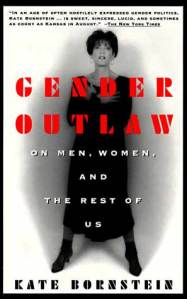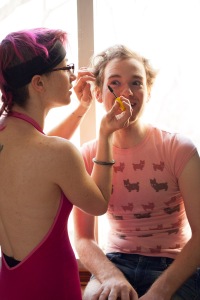Day 5 we focused on trans* issues and had a bit of a holiday to Walnut Creek, while day 6 we spent mostly learning about adolescent sexuality and sex and disability.
Montreal seems to be pretty supportive of trans* issues — there are a lot of queer events and inclusive spaces, and most of the workshops/ateliers I go to begin with having attendees introduce themselves by name and state their preferred pronouns. Obviously since I am not trans*, I don’t know what it is actually like, and I would never presume to speak for that community, but it seems pretty good. San Francisco is also pretty good, I’d assume: steeped in the queer culture I mentioned in the last post, it seems like most of my friends here are welcoming, enthusiastic people who like to wear bear costumes and laser cut robots and date genderqueer people.

This book is a GREAT resource for learning about trans*, genderqueer, and non-conforming gender identity/expression.r people.
Our panelists were an older man and a younger gender non-binary person (who goes by “he”) — the younger panelist was also asexual. I’ve really been appreciating the variety of panelists — many panelists, aside form being “lesbian” or whatever the reason for their appearance on the panel, openly discuss also being poly, kinky, asexual, whatever. Clearly these concepts are pretty new for a lot of the attendees, as we spend a lot of time discussing them.
For this panel, we discussed asexuality and non-binary gender presentation in depth, with some divergence into questions I personally found a little bit…iffy. Obviously if people don’t know things, they should ask, and it seemed like the majority of attendees had never met someone who identified as genderqueer or asexual before (and some had clearly never knowingly met a trans* person, either). One of the other attendees said she wasn’t sure what possible purpose could be served by asking some of those questions, and I have to agree. If you can’t think of a good reason you would need to know the answer to something, other than idle curiosity, maybe better not to ask it? I’m trying to be diplomatic here, obviously, but I admit to having a few cringey moments.
The general format of the workshops is also starting to get to me: we spend all day every day sitting in relatively uncomfortable chairs in an extremely stuffy room — no outside light and no fresh air. By midafternoon, most of us are completely exhausted. Since I am basically just a basket of tiny problems (I get sciatica if I sit too long, I have bunions, I get Restless Leg Syndrome if I drink caffeine after 4pm…anyone who wants to send me a cane to thwap the young whippersnappers with, feel free), this amount of sedentariness is terrible for my body and I find it difficult to get enough exercise and stretch. If the BART workers weren’t striking, I’d be walking a lot more, but as it is I mostly just feel like a creaky octogenarian. If you’re planning on coming to this workshop, be aware: lots of sitting.
After the trans* panel, we drove out to Walnut Creek for an “away day”. Again, I think I am a little bit jaded. I’ve been to Burning Man 5 times: if I’m surrounded by naked people and there’s nothing exploding or on fire, I tend to find it relatively tame. Also I’ve taken my clothes off in public so consistently that my mom said she thought I would grow up to be a nudist; I don’t find it to be a particularly intimate or shocking experience, but I forget that many other people don’t have the opportunity to be exposed (ha!) to group nudity that often.
Day 6 began with a guest speaking about adolescent sexuality…sort of. She didn’t seem particularly well-prepared, and her talk mostly just centered on personal stories about her children, who were not actually adolescents. I don’t know that I learned anything revolutionary from this section, although I did very much enjoy watching videos that one of the workshop facilitators had produced with a group of Hawaiian teenagers a few years ago. It reminded me of my own teenaged forays into playwriting and how incredibly CLEVER I thought I was. (I wasn’t.)
In the afternoon, we focused on sex and disability — everything that is facilitated and taught by the small group leader Jody is very well-prepared and excellently documented. He’s professional, enthusiastic, and explains things in an easy-to-understand and in-depth manner — he talked about trans* issues and also introduced the sex and disability section. We talked about physical disability, non-visible disability, and had a panelist come and discuss her sex life after acquiring ME. By the late afternoon, we were incredibly tired, and we still had a long evening of participating in the Sensorium exercise.
My interest and enthusiasm for the program is definitely starting to flag — I think if I were either learning something intellectually or learning something emotionally, I would be more upbeat, but…I feel like all of the information I have received was presented to a high standard through my Curtin sexology degree, and all of the emotional processing skills I’ve developed through years in therapy and meditation. I’m not perfect, by any means, and have a way to go. But I would stress for any potential future attendees: this is a very base-level course. This SAR is not designed for advanced sexologists, either people who have completed coursework in human sexuality, or people who have done a lot of processing on their own. I can get SOMETHING out of it, but it is mostly starting to feel a bit arduous to be spending all day, every day doing things I am already familiar with, when I could be spending time with my friends or going to workshops at the Center for Sex and Culture.
Or, I admit, going home and sleeping in my own bed.


I like the use of “iffy” here instead of the classic “problematic.”